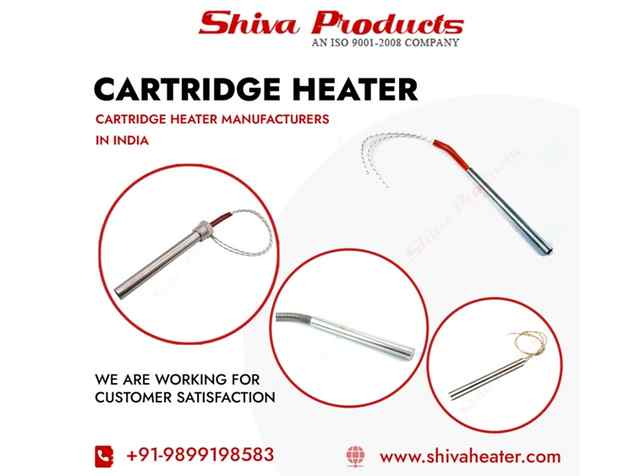Many businesses rely on heating as a central process in their production facilities. This is achieved by employing a wide range of industrial heaters, each of which has its unique design, watt density, and efficiency. One type of industrial heater is the Cartridge Heater, which has a wide range of uses, including the heating of metals, plastics, and immersion processes.
These heaters have become very popular in recent years, to the point where they are often chosen instead of more conventional models in the industrial heating market. Reading this post will answer your questions about these industrial heaters, how they operate, and where you may put them.
What is a Cartridge Heater
Heaters are cylindrical tube heating devices that quickly and precisely heat a wide range of materials, machinery, and equipment. Unlike an immersion heater, a heater is put into a hole to radiate heat from the inside out. They provide precisely directed localized heat and are used in various production operations.
The watt density of the heater may be adjusted to meet the application’s requirements and are simple to set up. To make for a more straightforward installation process, most heaters are manufactured with a diameter just slightly less than the diameter of the hole into which they are placed.
What is the function of a Cartridge Heater?
The heater has a ceramic core wrapped in a resistance coil with a dielectric between the two, all enclosed in a metal casing. The sheath warms up due to the power’s heat being conducted through the coil. This warmth is then transmitted to the metal component that has to be heated.
Most of the time, you only need a regular old drill to make a hole just right for a cartridge heater in a low or medium temperature application (600°F or less). Holes can be drilled.003″ to.008″ is more significant than the drill’s nominal size for a final fit.009″ to.014.”
This looser fit may not be ideal for heat conduction, but it makes heaters, especially ones with long sheaths, easier to install and remove. An exact match becomes increasingly crucial at high power densities. Instead of just drilling the holes with a regular bit, you should drill and reamer them. Less heat will be generated, and the heater will last longer if it fits more snugly.
Where can I find information on the safest temperatures for using a Cartridge Heater?
Low, medium and high watt densities are all possible with a heater. They can keep working even when the temperature outside reaches 1400 degrees Fahrenheit. It is important to note that the heater’s optimum working temperature is context-dependent.
However, the actual temperature of an Infrared Heater and the monitored temperature of a material during the heating cycle can be affected by several variables, including the watt density of the heater, the tightness of the cartridge inside the hole, and the thermal conductivity of the material being heated. Maximum heat transmission and durability are achieved when Incoloy sheathing is used in applications where the temperature is more than 1000 degrees Fahrenheit.
The cartridge’s electrical termination should also be thought of about the working temperature. In cases where heaters will be subjected to temperatures above their normal operating range, the electric terminals should be a different material.
When compared to the typical high-temperature lead wires, the cartridge should be constructed so that the area immediately surrounding the lead wires never reaches temperatures above their own.
When would you utilize a heater?
Heat transfer is far more efficient with cheaters supplied by Cartridge Heater suppliers in India. You can get temperatures up to 800 degrees Celsius with them, making them ideal for demanding localized heating. For instance, they are commonly used to preheat metal tools like dies, molds, and platens. The heating element fits securely inside a tiny opening, and conduction ensures that the heat is transferred consistently and uniformly.
It’s also possible to use them for:
- Power-hungry users that need a lot of power per unit area
- Reducing condensation by controlling the temperature of the air in devices (e.g., control panels, closed circuits)
- To heat fluids: (including water and chemical solutions)
- Moulding with rubber
Medical, food processing, packaging, and plastic molding are just some industries that regularly employ cartridge warmers. However, they are an adaptable and long-lasting heating element that may be used in various industrial settings.
The Advantages of Heaters Over Competing Industrial Heaters
Because of their widespread adoption, you can readily locate them in various brands. These heaters have been increasingly popular due to some of their shared characteristics, even as each company has developed its unique twists on them.
Compact Design: The Magnesium Oxide in these industrial heaters is compacted by a swaged design, resulting in a dense dielectric with superior heat transmission characteristics (changed to correct). The swage pattern is effective at dampening vibration and impact (Omit). The small size makes it simple to fit into tight spaces, such as injection moulds or die blocks.
Suited for a Wide Range of Temperature Applications: The heater is adaptable to various uses, including those that require high or low temperatures. For instance, they are utilized to prevent condensation by controlling the air temperature in various equipment. They are also resistant to temperatures as high as 1400°F.
Effective Energy Transfer: One of the main advantages of these heaters is that they transmit heat efficiently, wasting very little heat in the process. The heating element is protected from oxidation thanks to the surrounding copper sheath. Since the heating element is physically touching the object it is warming, efficient heat transfer is guaranteed.
Reduced Electricity Bills: Minimizing heat loss results in lower electricity costs. There is the potential for significant cost savings for end customers.
Conclusion:
Cartridge Heater Manufacturers In India, Shiva Products is a household name. We have an experienced team of designers and manufacturers who collaborate to provide a full line of heaters used in various commercial enterprises and applications where temperature control is critical.
In both their regular and “D” structures, the metal, stainless steel, and Incoloy that go into making every one of our heaters are of the highest quality.


